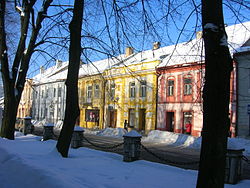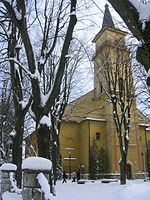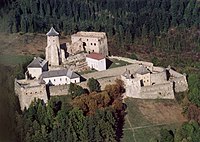Stará Ľubovňa
| Stará Ľubovňa | ||
|---|---|---|
| coat of arms | map | |

|
|
|
| Basic data | ||
| State : | Slovakia | |
| Kraj : | Prešovský kraj | |
| Okres : | Stará Ľubovňa | |
| Region : | Spiš | |
| Area : | 30.786 km² | |
| Residents : | 16,327 (Dec. 31, 2019) | |
| Population density : | 530 inhabitants per km² | |
| Height : | 545 m nm | |
| Postal code : | 064 01 | |
| Telephone code : | 0 52 | |
| Geographic location : | 49 ° 18 ' N , 20 ° 42' E | |
| License plate : | SL | |
| Kód obce : | 526665 | |
| structure | ||
| Community type : | city | |
| Urban area structure: | 2 districts | |
| Administration (as of November 2018) | ||
| Mayor : | Ľuboš Tomko | |
| Address: | Mestský úrad Stará Ľubovňa Obchodná 1 06401 Stará Ľubovňa |
|
| Website: | www.staralubovna.sk | |
| Statistics information on statistics.sk | ||
Stará Ľubovňa (German Lublau or Altlublau , Polish Lubowla , Hungarian Ólubló - older also Lubló ) is a city with about 15,000 inhabitants in northeastern Slovakia .
The city consists of the districts Podsadek (incorporated in 1964; German Sadek or Heichen ) and Stará Ľubovňa.
Location and sights
Stará Ľubovňa is located 15 km south of the Polish border on Poprad east of the High Tatras . It is one of the oldest towns in the Spis region. The castle of the same name rises above the town, some of which is still in good condition and today houses a museum about the history of the castle. Next to the castle is the open-air museum Stará Ľubovňa , (Slovak - Ľubovňansky skanzen ), which was opened in 1985. The most important exhibit is the wooden Greek-Catholic church from Matysová, which was built in 1833 and is dedicated to the Archangel Michael. Furthermore, wooden houses from the beginning of the 20th century from various villages in the area are shown.
The heart of the old town is the rectangular St. Nikolaus-Platz, which is surrounded by town houses from the 17th century. In its center there is a small park and the Gothic Roman Catholic St. Nicholas Church. The fortifications that enclosed the square and the streets surrounding it are only preserved in two places.
The Greek Catholic Church, which was blessed on April 22, 1990 by Pope John Paul II, is also interesting . The church is constructed in the shape of a crown and forms a religious complex with a monastery, a bell tower and an amphitheater.
history
In 1292 Stará Ľubovňa was first mentioned in writing under the name Libenow . Until its elevation to the (royal) town in 1342 Stará Ľubovňa was subordinate to the castle.
In 1412 it was one of the 13 Spis towns that the Hungarian King Sigismund of Luxembourg pledged to the Polish King Władysław II Jagiełło for 37,000 Prague silver groschen . The pledge should not take long, but Sigismund did not return the borrowed money and Poland later refused to return the money, so the cities remained Polish pledges for 360 years. Only in the course of the first partition of Poland in 1772 under Maria Theresa did the area return completely to the Kingdom of Hungary. Thereafter (1778–1876) the city belonged to the province of 16 Spiš cities .
The pledge was actually advantageous for the residents, because they did not have to submit to the county or the nobility and took a neutral position in the event of unrest between Poland and the Kingdom of Hungary; The area was administered by Polish community leaders from the Ľubovňa castle, but did not become part of Poland. The city of Stará Ľubovňa gained in importance and became more important than the neighboring town of Podolínec .
In 1414 the city received another privilege: the citizens were exempted from half of Krakow's duty.
On April 11, 1556, the town, which at that time consisted mostly of wooden houses, was largely destroyed by a major fire - only six houses remained.
In the middle of the 18th century Stará Ľubovňa even had its own currency, the Ľubovniansky zloty , which was minted in Stará Ľubovňa and used in the pledged area.
In the post-war period there was a collection camp in Stará Ľubovňa as part of the expulsion of the Carpathian Germans .
sons and daughters of the town
- Marián Hossa (* 1979), Slovak ice hockey player.
See also
literature
- Okresný národný výbor: Okres Stara Ľubovňa
- Turistický sprievodca: Slovenské kráľovské mestá Bardejov , Kežmarok, Levoča, Stará Ľubovňa









